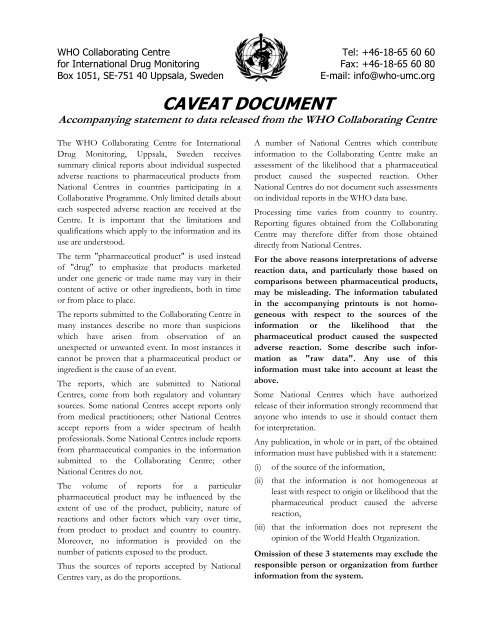VigiSearch application form - Uppsala Monitoring Centre
VigiSearch application form - Uppsala Monitoring Centre
VigiSearch application form - Uppsala Monitoring Centre
Create successful ePaper yourself
Turn your PDF publications into a flip-book with our unique Google optimized e-Paper software.
WHO Collaborating <strong>Centre</strong> Tel: +46-18-65 60 60<br />
for International Drug <strong>Monitoring</strong> Fax: +46-18-65 60 80<br />
Box 1051, SE-751 40 <strong>Uppsala</strong>, Sweden<br />
E-mail: info@who-umc.org<br />
CAVEAT DOCUMENT<br />
Accompanying statement to data released from the WHO Collaborating <strong>Centre</strong><br />
The WHO Collaborating <strong>Centre</strong> for International<br />
Drug <strong>Monitoring</strong>, <strong>Uppsala</strong>, Sweden receives<br />
summary clinical reports about individual suspected<br />
adverse reactions to pharmaceutical products from<br />
National <strong>Centre</strong>s in countries participating in a<br />
Collaborative Programme. Only limited details about<br />
each suspected adverse reaction are received at the<br />
<strong>Centre</strong>. It is important that the limitations and<br />
qualifications which apply to the in<strong>form</strong>ation and its<br />
use are understood.<br />
The term "pharmaceutical product" is used instead<br />
of "drug" to emphasize that products marketed<br />
under one generic or trade name may vary in their<br />
content of active or other ingredients, both in time<br />
or from place to place.<br />
The reports submitted to the Collaborating <strong>Centre</strong> in<br />
many instances describe no more than suspicions<br />
which have arisen from observation of an<br />
unexpected or unwanted event. In most instances it<br />
cannot be proven that a pharmaceutical product or<br />
ingredient is the cause of an event.<br />
The reports, which are submitted to National<br />
<strong>Centre</strong>s, come from both regulatory and voluntary<br />
sources. Some national <strong>Centre</strong>s accept reports only<br />
from medical practitioners; other National <strong>Centre</strong>s<br />
accept reports from a wider spectrum of health<br />
professionals. Some National <strong>Centre</strong>s include reports<br />
from pharmaceutical companies in the in<strong>form</strong>ation<br />
submitted to the Collaborating <strong>Centre</strong>; other<br />
National <strong>Centre</strong>s do not.<br />
The volume of reports for a particular<br />
pharmaceutical product may be influenced by the<br />
extent of use of the product, publicity, nature of<br />
reactions and other factors which vary over time,<br />
from product to product and country to country.<br />
Moreover, no in<strong>form</strong>ation is provided on the<br />
number of patients exposed to the product.<br />
Thus the sources of reports accepted by National<br />
<strong>Centre</strong>s vary, as do the proportions.<br />
A number of National <strong>Centre</strong>s which contribute<br />
in<strong>form</strong>ation to the Collaborating <strong>Centre</strong> make an<br />
assessment of the likelihood that a pharmaceutical<br />
product caused the suspected reaction. Other<br />
National <strong>Centre</strong>s do not document such assessments<br />
on individual reports in the WHO data base.<br />
Processing time varies from country to country.<br />
Reporting figures obtained from the Collaborating<br />
<strong>Centre</strong> may therefore differ from those obtained<br />
directly from National <strong>Centre</strong>s.<br />
For the above reasons interpretations of adverse<br />
reaction data, and particularly those based on<br />
comparisons between pharmaceutical products,<br />
may be misleading. The in<strong>form</strong>ation tabulated<br />
in the accompanying printouts is not homogeneous<br />
with respect to the sources of the<br />
in<strong>form</strong>ation or the likelihood that the<br />
pharmaceutical product caused the suspected<br />
adverse reaction. Some describe such in<strong>form</strong>ation<br />
as "raw data". Any use of this<br />
in<strong>form</strong>ation must take into account at least the<br />
above.<br />
Some National <strong>Centre</strong>s which have authorized<br />
release of their in<strong>form</strong>ation strongly recommend that<br />
anyone who intends to use it should contact them<br />
for interpretation.<br />
Any publication, in whole or in part, of the obtained<br />
in<strong>form</strong>ation must have published with it a statement:<br />
(i) of the source of the in<strong>form</strong>ation,<br />
(ii) that the in<strong>form</strong>ation is not homogeneous at<br />
least with respect to origin or likelihood that the<br />
pharmaceutical product caused the adverse<br />
reaction,<br />
(iii) that the in<strong>form</strong>ation does not represent the<br />
opinion of the World Health Organization.<br />
Omission of these 3 statements may exclude the<br />
responsible person or organization from further<br />
in<strong>form</strong>ation from the system.
















